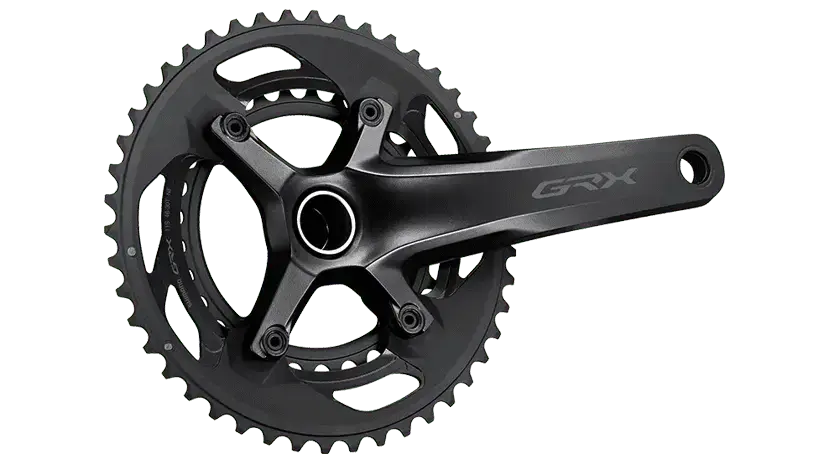CassidyAce
Senior Retro Guru
Long post alert!
After some recent debate about the merits of 1x versus 3x gearing on this site, I decided to go through the maths. There are tables of gear ratios and so on to be found elsewhere but I wanted to investigate for myself. I’ve been wondering about some of the new, flat bar gravel bikes, and they typically come in 1x only, so there was a personal reason for going through the numbers too.
However, let’s face it, 1x vs 3x is not a debate that’s going on in the wider mountain biking world: 1x is the de facto winner. But I think it’s fair to say that 1x is the winner not because it offers a superior range of gears but because the range of gears has been slightly compromised in favour of other features to do with chain retention, frame design and dropper posts. Since the problems those features solve are not really problems for me however, I’m still interested in 1x vs 3x gearing.
Don’t expect an argument in favour of 1x or 3x though. If there’s an overall message, it’s ‘Don’t be simplistic’, and that’s all. If you already know it all, good. However, I suspect that’s rare—either that or the disingenuously selective use of figures is not rare.
Maths note: figures involving a decimal have been rounded to two decimal places. Here goes . . .
Gear Ratios
The following table shows a range of gear ratios:

A number of observations can be made:
(1) The range of gear ratios increases with increases in the tooth count of the chainring. On a 1x drivetrain, with a 10-51 cassette and a 30t chainring, there is a range of 2.41 (=3.00-0.59); with a 40t chainring, a range of 3.22 (=4.00-0.78 ); with a 50t chainring, a range of 4.02 (=5.00-0.98 ). [Spaces added inside brackets to prevent 'auto-correction' to 'Cool' emoji.] If we assume that the bigger the range, the better the range of gears, we might choose a 50t chainring, and that might be fine on a road bike, but it would be lousy on a modern MTB. So, on its own, the numerical range of gear ratios is not a good guide to a suitable drivetrain.
(2) Neither is the largest gear ratio as a percentage of the smallest gear ratio. On a 1x drivetrain, that percentage will always be simply the biggest chainring as a percentage of the smallest (because the chainring is always the same, the equation simplifies to largest sprocket/smallest sprocket, as a %). On a 10-51 cassette, that percentage will always be 510% (=51/10), regardless of chainring. (The rounding to two decimal places in the table slightly blurs that, but you can check for yourself with the full figures.) Should this percentage figure help us choose one drivetrain over another? On its own, no. It doesn’t tell us whether the gear ratios in question are, actually, useful ones for the bike in question. It doesn’t tell us whether the chainring is too large, too small, or about right. On its own, it’s a bit useless. However, in comparison with a drivetrain that has, say, a 480% range and the same, useful, chainring, yes, it does tell us something worth knowing. In other words, figures out of context can deceive as easily as inform—as politicians and marketing folk well know—but, in context, they might help.
(3) Does a 3x drivetrain offer a bigger and better range of gears than a 1x drivetrain? Sometimes, yes. Sometimes, no. The answer depends on the size of the chainrings involved. A 1x drivetrain with a 32t chainring and a 10-51 cassette gives a range of 2.57 (=3.20-0.63) and 510%. My daily rider is 3x, with 42-32-22 at the front, and an 11-32 eight speed SRAM cassette. That gives a range of (3.82-0.69=) 3.13 and 554%. Whoopee for 3x! Or is it? I quite like the look of the current Marin DSX2 (except for the brown paint job) and that is 1x, with a 10-51 cassette and a 42t chainring: 510% again (obviously) but a 4.20-0.82=3.38 range. Smaller percentage than my current 3x but a bigger range of ratios. Cool! But perhaps that bigger range is because the gearing is too high for where I live. Not cool. But if it is right for where I live, cool again . . .
Wheel Sizes and Gear Inches
The above is all very well but it does not factor in different wheel sizes. Why does that matter? Because larger wheel sizes magnify the differences in gear ratios into larger differences in gear inches. In fact, it’s possible to have a smaller spread of gear ratios on a 29er than a 26er, but still have a wider range of speeds on the 29er at any given cadence. This applies regardless of whether the drivetrain is 1x or 3x.
The table below shows wheel circumferences, assuming that pi is 3.14 and wheels, fitted with tyres, really are 29”, 27.5” and 26”. However, in practice, tyre deformation affects rolling circumference.

Now, if this information is combined with the table of gear ratios, we can get the following three tables of gear inches:



My 26” bike with 42-32-22 up front and an 11-32 cassette has 311.72” of forward motion per revolution of the pedals in the highest gear and 56.13” in the smallest, giving a range of 255.59”. The figures for a 29er with the same gearing would be 347.68” and 59.37”, giving a range of 285.08”.
However, the modern 29er is more likely to be a 1x with a cassette in the region of 10-51, so how does that compare? With a 32t chainring, the 29er would have a high of 291.31” and a low of 57.14”, giving a range of 234.17”. The lowest gearing is roughly the same as my 26er’s but the highest falls a little short. On the other hand, the DSX2, with its 42t chainring and roughly 29er wheels, has a high of 382.45” and a low of 74.99”, giving a range of 307.46”. That’s a bigger range than my 26er but the low isn’t really low enough for around here. A 34t chainring, with a 10-51 cassette and 29” wheels is another matter: a low of 60.71” and a high of 309.60”, which are values very, very close to those of my 26er if it had an 11-30 cassette.
On the other hand, my 1996 Stinson, with 42-32-22 and 11-32 has a high that’s the same as the DSX2’s (with 42t chainring) but a low of 62.60”. For the range of gear inches alone, neither the DSX2 nor the modern 1x 29er MTB can quite compete, although they might have other benefits, like disc brakes. There is also an issue of whether a rider really needs such a wide spread of gear inches and that very much depends on the rider and the terrain. In a flatter area, 1x would probably be adequate, for me anyway. However, I live in an area where I am often going up and down short but steep hills. I use the full range of my gears. Moreover, I am often changing quickly from low down the gears to high up, and vice versa, and the ability to shift chainrings makes that easier.
Again, then, and at the risk of stating the obvious, the figures can help but only in context, and although there might be a best for me and a best for you, there is no best without qualification.
Top Speed and Spinning Out
If you know the speed you reach, in MPH, as you start to spin out, you can work out the cadence (in RPM) using the following:
Cadence = (MPH x 63,360) ÷ (60 x Gear inches)
[63,360 is the number of inches per mile]
Alternatively, if you know the cadence at which you spin out, you can work out the speed, in MPH, using the following:
MPH = (Gear Inches x Cadence x 60) ÷ 63,360
As a non-elite, middle-aged cyclist, riding for fun and fitness, I will spin out at a cadence of around 90-100 rpm and, frankly, I couldn’t sustain that for long. On my 26” daily rider, those cadences give a speed of between 26.57 MPH and 29.52 MP. If I reach higher speeds, that’s due to the assistance of gravity. On the DSX2 (or my Stinson) those cadences would generate speeds between 32.63 MPH and 36.25 MPH. On a 29er with a 1x drivetrain, a 32t chainring, and a 10-51 cassette, I would be spinning out at speeds between 24.83 MPH and 27.59 MPH. However, once gravity takes over, the benefits of the 29er’s momentum and ability to rollover small objects will probably make the 29er the quicker bike. Indeed, evidence suggests that 29ers are faster for modern mountain biking purposes; however, if they are, that is likely to be due to factors other than their range of gear ratios.
Obviously, although top speed contributes to average (mean) speed, it is higher average speeds that get riders from A to B faster. For that reason, sprockets in the middle of the cluster that enable incremental improvements in modal speed (most common speed) might be more important for average (mean) speed than the sheer range of gears.
Conclusion
So, 1x vs 3x? There are no bragging rights or sneering rights, and the game of one upmanship is a fool’s errand.
After some recent debate about the merits of 1x versus 3x gearing on this site, I decided to go through the maths. There are tables of gear ratios and so on to be found elsewhere but I wanted to investigate for myself. I’ve been wondering about some of the new, flat bar gravel bikes, and they typically come in 1x only, so there was a personal reason for going through the numbers too.
However, let’s face it, 1x vs 3x is not a debate that’s going on in the wider mountain biking world: 1x is the de facto winner. But I think it’s fair to say that 1x is the winner not because it offers a superior range of gears but because the range of gears has been slightly compromised in favour of other features to do with chain retention, frame design and dropper posts. Since the problems those features solve are not really problems for me however, I’m still interested in 1x vs 3x gearing.
Don’t expect an argument in favour of 1x or 3x though. If there’s an overall message, it’s ‘Don’t be simplistic’, and that’s all. If you already know it all, good. However, I suspect that’s rare—either that or the disingenuously selective use of figures is not rare.
Maths note: figures involving a decimal have been rounded to two decimal places. Here goes . . .
Gear Ratios
The following table shows a range of gear ratios:
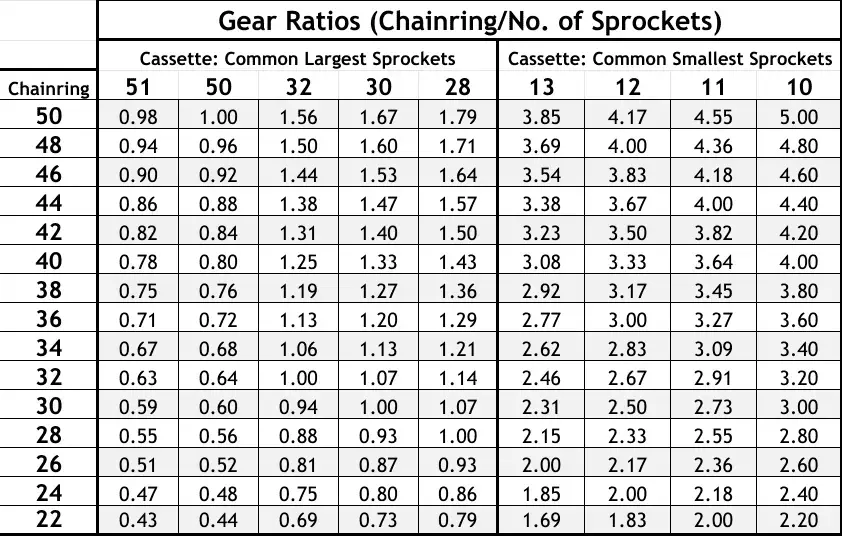
A number of observations can be made:
(1) The range of gear ratios increases with increases in the tooth count of the chainring. On a 1x drivetrain, with a 10-51 cassette and a 30t chainring, there is a range of 2.41 (=3.00-0.59); with a 40t chainring, a range of 3.22 (=4.00-0.78 ); with a 50t chainring, a range of 4.02 (=5.00-0.98 ). [Spaces added inside brackets to prevent 'auto-correction' to 'Cool' emoji.] If we assume that the bigger the range, the better the range of gears, we might choose a 50t chainring, and that might be fine on a road bike, but it would be lousy on a modern MTB. So, on its own, the numerical range of gear ratios is not a good guide to a suitable drivetrain.
(2) Neither is the largest gear ratio as a percentage of the smallest gear ratio. On a 1x drivetrain, that percentage will always be simply the biggest chainring as a percentage of the smallest (because the chainring is always the same, the equation simplifies to largest sprocket/smallest sprocket, as a %). On a 10-51 cassette, that percentage will always be 510% (=51/10), regardless of chainring. (The rounding to two decimal places in the table slightly blurs that, but you can check for yourself with the full figures.) Should this percentage figure help us choose one drivetrain over another? On its own, no. It doesn’t tell us whether the gear ratios in question are, actually, useful ones for the bike in question. It doesn’t tell us whether the chainring is too large, too small, or about right. On its own, it’s a bit useless. However, in comparison with a drivetrain that has, say, a 480% range and the same, useful, chainring, yes, it does tell us something worth knowing. In other words, figures out of context can deceive as easily as inform—as politicians and marketing folk well know—but, in context, they might help.
(3) Does a 3x drivetrain offer a bigger and better range of gears than a 1x drivetrain? Sometimes, yes. Sometimes, no. The answer depends on the size of the chainrings involved. A 1x drivetrain with a 32t chainring and a 10-51 cassette gives a range of 2.57 (=3.20-0.63) and 510%. My daily rider is 3x, with 42-32-22 at the front, and an 11-32 eight speed SRAM cassette. That gives a range of (3.82-0.69=) 3.13 and 554%. Whoopee for 3x! Or is it? I quite like the look of the current Marin DSX2 (except for the brown paint job) and that is 1x, with a 10-51 cassette and a 42t chainring: 510% again (obviously) but a 4.20-0.82=3.38 range. Smaller percentage than my current 3x but a bigger range of ratios. Cool! But perhaps that bigger range is because the gearing is too high for where I live. Not cool. But if it is right for where I live, cool again . . .
Wheel Sizes and Gear Inches
The above is all very well but it does not factor in different wheel sizes. Why does that matter? Because larger wheel sizes magnify the differences in gear ratios into larger differences in gear inches. In fact, it’s possible to have a smaller spread of gear ratios on a 29er than a 26er, but still have a wider range of speeds on the 29er at any given cadence. This applies regardless of whether the drivetrain is 1x or 3x.
The table below shows wheel circumferences, assuming that pi is 3.14 and wheels, fitted with tyres, really are 29”, 27.5” and 26”. However, in practice, tyre deformation affects rolling circumference.
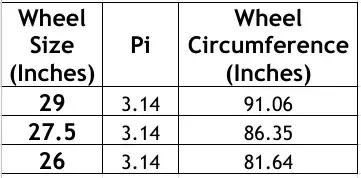
Now, if this information is combined with the table of gear ratios, we can get the following three tables of gear inches:
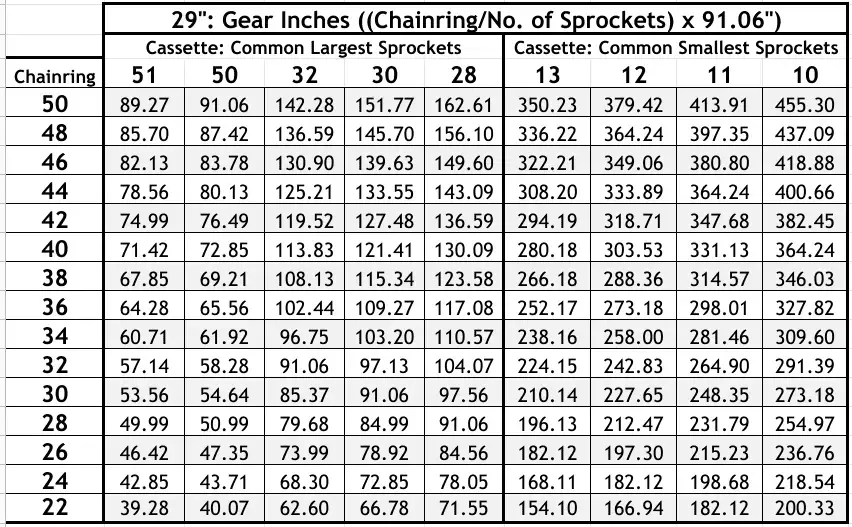
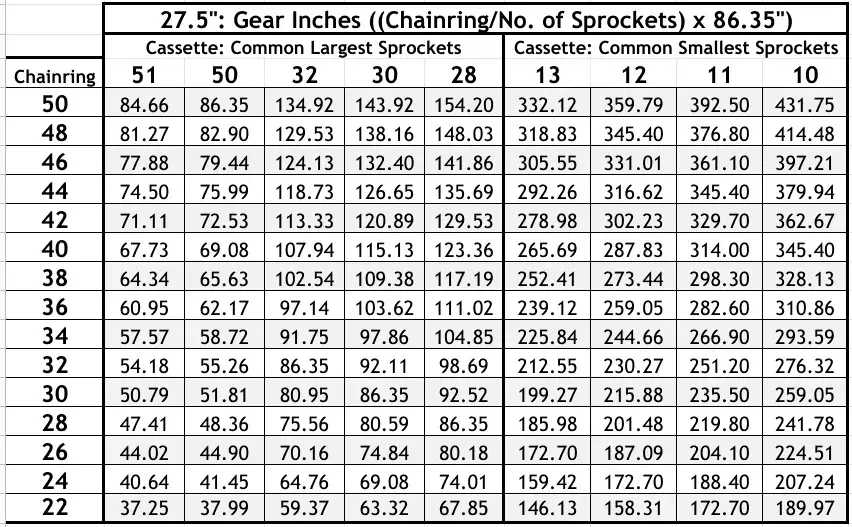
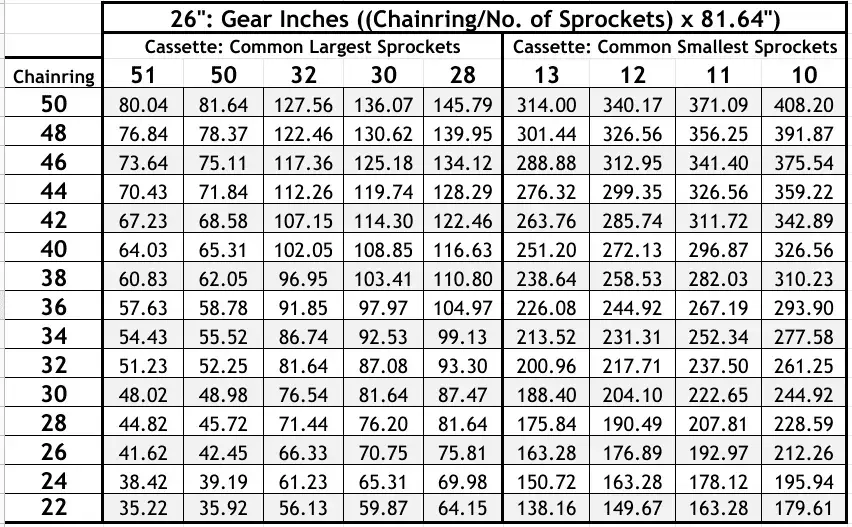
My 26” bike with 42-32-22 up front and an 11-32 cassette has 311.72” of forward motion per revolution of the pedals in the highest gear and 56.13” in the smallest, giving a range of 255.59”. The figures for a 29er with the same gearing would be 347.68” and 59.37”, giving a range of 285.08”.
However, the modern 29er is more likely to be a 1x with a cassette in the region of 10-51, so how does that compare? With a 32t chainring, the 29er would have a high of 291.31” and a low of 57.14”, giving a range of 234.17”. The lowest gearing is roughly the same as my 26er’s but the highest falls a little short. On the other hand, the DSX2, with its 42t chainring and roughly 29er wheels, has a high of 382.45” and a low of 74.99”, giving a range of 307.46”. That’s a bigger range than my 26er but the low isn’t really low enough for around here. A 34t chainring, with a 10-51 cassette and 29” wheels is another matter: a low of 60.71” and a high of 309.60”, which are values very, very close to those of my 26er if it had an 11-30 cassette.
On the other hand, my 1996 Stinson, with 42-32-22 and 11-32 has a high that’s the same as the DSX2’s (with 42t chainring) but a low of 62.60”. For the range of gear inches alone, neither the DSX2 nor the modern 1x 29er MTB can quite compete, although they might have other benefits, like disc brakes. There is also an issue of whether a rider really needs such a wide spread of gear inches and that very much depends on the rider and the terrain. In a flatter area, 1x would probably be adequate, for me anyway. However, I live in an area where I am often going up and down short but steep hills. I use the full range of my gears. Moreover, I am often changing quickly from low down the gears to high up, and vice versa, and the ability to shift chainrings makes that easier.
Again, then, and at the risk of stating the obvious, the figures can help but only in context, and although there might be a best for me and a best for you, there is no best without qualification.
Top Speed and Spinning Out
If you know the speed you reach, in MPH, as you start to spin out, you can work out the cadence (in RPM) using the following:
Cadence = (MPH x 63,360) ÷ (60 x Gear inches)
[63,360 is the number of inches per mile]
Alternatively, if you know the cadence at which you spin out, you can work out the speed, in MPH, using the following:
MPH = (Gear Inches x Cadence x 60) ÷ 63,360
As a non-elite, middle-aged cyclist, riding for fun and fitness, I will spin out at a cadence of around 90-100 rpm and, frankly, I couldn’t sustain that for long. On my 26” daily rider, those cadences give a speed of between 26.57 MPH and 29.52 MP. If I reach higher speeds, that’s due to the assistance of gravity. On the DSX2 (or my Stinson) those cadences would generate speeds between 32.63 MPH and 36.25 MPH. On a 29er with a 1x drivetrain, a 32t chainring, and a 10-51 cassette, I would be spinning out at speeds between 24.83 MPH and 27.59 MPH. However, once gravity takes over, the benefits of the 29er’s momentum and ability to rollover small objects will probably make the 29er the quicker bike. Indeed, evidence suggests that 29ers are faster for modern mountain biking purposes; however, if they are, that is likely to be due to factors other than their range of gear ratios.
Obviously, although top speed contributes to average (mean) speed, it is higher average speeds that get riders from A to B faster. For that reason, sprockets in the middle of the cluster that enable incremental improvements in modal speed (most common speed) might be more important for average (mean) speed than the sheer range of gears.
Conclusion
So, 1x vs 3x? There are no bragging rights or sneering rights, and the game of one upmanship is a fool’s errand.
